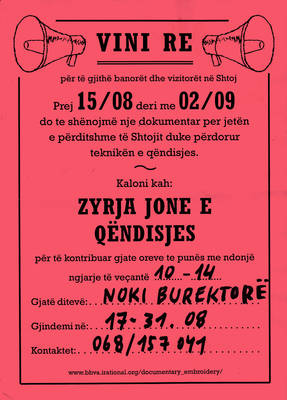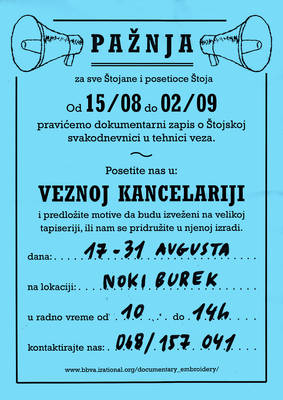KRAJ LETA U DONJEM ŠTOJU
END OF SEASON IN DONJI ŠTOJ
1a stanica na turneji dokumentarnog veza
u Donjem Štoju (Ulcinj, Crna Gora) od 15og Avgusta do 3eg Septembra
DAYS_DANI
| POSTERS_POSTERI
| DOCUMENTS_DOKUMENTA
During 20 days, the embroidery office opened its proverbial doors to
the public at Stoj, talking to workers and vacationers, collecting impressions,
stories and drawings, and transforming them into a large scale tapestry.
The materials that were used were locally recycled materials, obtained
from two different tailor-shops from Ulcinj. This gives the tapestry a
different look than previous Documentary Embroidery works. We embroidered
in several local businesses, talking to workers and locals about the nature
of the place. The embroideries made depict a variety of issues such as
the changing of the street-names (as a result of the changing of the population),
the effects of tourism on infrastructure and on the natural sphere and
many others. U odnosu na dosadasnje poduhvate dokumentarnog veza stojska tapiserija
je specificna jer je radjena na tekstilnim restlovima nabavljenim iz lokalnih
snajderskih radnji koje su u letnjem periodu uglavnom dobijale poslove
prepravljenja dugih pantalona u sorceve. Na ovim komadima nejednakih velicina
i formi (predominantno restlova farmerki) iz dana u dan vezli su se partikularni
detalji iz lokalnog zivota o kojima se nasiroko diskutovalo sa lokalnim
prolaznicima, namernicima, prodavcima, komsijama, ugostiteljima. A ovi
delovi su se malo po malo spajali jedan sa drugim u tapiseriju velikog
formata. Tako je izmedju ostalog zabelezena istorija menjanja naziva ulica
u Donjem Stoju, naizmenicne migracije turista (iz eks-Ju regiona) tokom
leta i ptica tokom zime ciji dolazak takodje povlaci i najezdu lovaca,
onda ‘Bostan fontana’ (specifican nacin prodavanja lubenica
na putu), prica o jednoj sovi koja je nasla svoje staniste u odzaku te
zbog nje vlasnik kuce ne lozi vec 10 godina, zatim prizor iz lokalne ‘mitologije’
na terasi Hotela Galeb gde su se lokalni mladici takmicili u stilu, sarmantnosti
i ucili jedni od drugih, varietet jela koja se spremaju u jednoj stojskoj
tepsiji, itd. Tekstualni zapisi na tapiseriji ne postuju jezicku koherentnost
te se sadrzaj moze citati na raznim lokalnim jezicima i narecjima. Special thanks to Vahida Nimanbegu, Nebojsa Milikic, Negovo Visocanstvo Zlaja, Filip, Dusko i Ivana Kamber,
Mira i Zvonko Rondic, Ivana, Branko i Aleksa Brankovic, svom osoblju iz Noki Bureka, Anji za reportazu i Maju za tekstilne restlove, Samiru Dabovicu, i mnogima drugim..
_____________________________________________________________________________________________________________________________________________________
1st stataion of Documentary Embroidery Circuit
from August 15th till September 3rd in Donji Stoj (Ulcinj, Montenegro).

MORE IMAGES / JOS FOTOGRAFIJA >Shtoy, administratively belonging to the municipality
of Ulcinj is placed on the south Adriatic coast of Montenegro, 8km from
the Albanian border. For this reason the population of Shtoy and Ulcinj
is predominantly Albanian, a minority in Montenegro. Its location in the
vicinity of the delta of the Bojana river provides a rich variety of continental
and maritime vegetation and animal life to the whole region. Another particularity
of Shtoy’s history lay in the fact that it really has only been 3
decades since working-class people from all over ex-Yugoslavia started building
their weekend houses there, causing a burst of urbanization, in what was
previously a rural area.
Nowadays Shtoy is a socially interesting place, a temporary harmonious “autonomous
zone” for Serbs, Albanians, Kosovo-Albanians, Bosnians, Montenegrins
and Croats during the summer vacation. This creates a unique mixed situation
that can rarely be seen anywhere in today’s situation of constant
political tensions.


